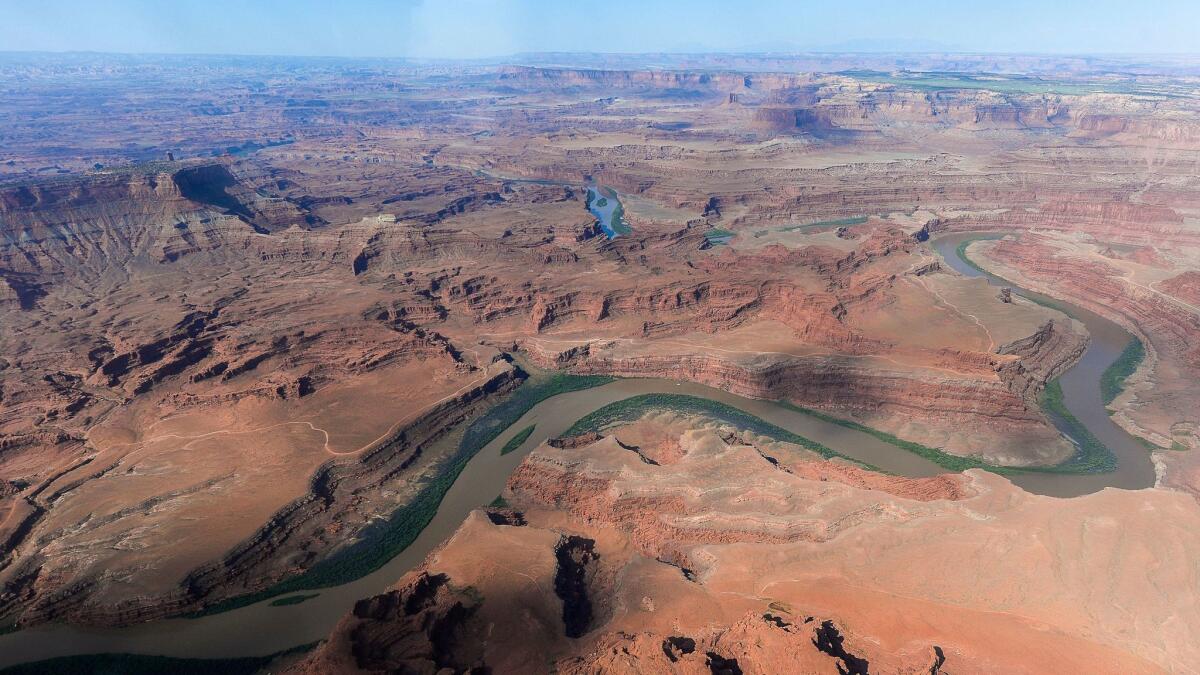Op-Ed: It’s magical legal thinking to say Trump can’t reverse Obama’s national monuments

Suppose President Trump declared much of California, Nevada and Oregon — states that just happened to vote against him — off-limits to economic development and recreational use. Suppose he barred all mining, grazing, agriculture and even camping from these states’ federal lands (roughly 46% of California, 85% of Nevada and 53% of Oregon) under a law to preserve national monuments of scientific and historical interest.
According to some environmentalists and legal scholars, we would have to live with this result. They believe a president can permanently designate federal land as a monument and restrict its uses — even if we’re talking about millions of acres (138 million acres in the example above), far removed from any real historical or scientific significance, and over the objections of the states involved.
But a presidential power to create permanent national monuments flies in the face of the plain text of federal law, the conventional relationship between presidents and Congress and historical understandings of executive power. Trump has the right to reverse the national monuments created by previous presidents without an act of Congress, but by the same token, the Constitution creates a check by allowing future presidents to reverse Trump too.
In late April, Trump announced a plan to reconsider the size of recently designated national monuments, principally those that withdrew vast amounts of land in the West and in the oceans near Hawaii and New England from some forms of economic development. His orders sparked a firestorm of criticism from environmentalists and sympathetic public officials, who have argued in these pages that Trump cannot undo a national monument once declared by a past president.
It’s simply unrealistic to pretend that acts created by unilateral presidential decrees cannot be undone in the same manner.
The power to create national monuments derives from the Antiquities Act of 1906. It’s a broad presidential power, although monuments must be limited to the smallest area necessary to preserve landmarks and other objects of interest. Like many federal laws, the Antiquities Act delegates authority to the executive branch but does not address how to undo the use of the power. Those who defend permanent, unchangeable national monuments argue that the act’s silence on reversal means reversal is impossible. But there is no reason to believe that the Antiquities Act can uniquely evade the fundamental principles that apply throughout our government and laws.
Almost every grant of power, by Constitution or statute, implicitly also includes the power of reversal. Congress has no express authority in the Constitution to repeal a law, but it does so by passing new laws. The Supreme Court doesn’t have express authority to overrule a past precedent, but it does so in a later decision. As the federal courts have recognized, the president can fire Cabinet officers or abrogate treaties (both of which require Senate advice and consent), even though the Constitution doesn’t mention it. No Congress, Supreme Court or president can bind their successors from using their branch’s constitutional powers.
The courts have applied the same legal principle of reversal when Congress delegates lawmaking power to the executive branch, as in the Antiquities Act. For example, agencies granted authority to issue regulations also can revoke or modify them, and presidents often repeal executive orders, many of which are based on statutory powers. The courts have never held that the underlying statutory authority once used cannot be revoked.
Indeed, those who claim that the Antiquities Act does not grant a reversal power cannot find a single case in another area of federal law that supports that contention. To override the norm, legislators have to clearly limit reversal powers in the original law; the plain text of the Antiquities Act includes no such limits.
Those who consider monument proclamations sacrosanct place most of their hopes in a cursory legal opinion issued by U.S. Atty. Gen. Homer Cummings in 1938. No court has ever approved of the Cummings opinion. Our research explains the many holes in its reasoning, including Cummings’ mistaken reliance on an 1862 attorney general opinion that interpreted a different law, with utterly different facts, and, in any case, reached a conclusion contrary to Cummings’ position.
In a letter to the Interior Department, California Atty. Gen. Xavier Becerra asserts that Trump cannot legally revoke or reduce six national monuments in California. Besides his reliance on Cummings’ flawed opinion, Becerra’s statutory citations don’t help his case. He primarily cites ambiguous comments made in House committee deliberations related to the Federal Land Policy and Management Act of 1976. But that is a separate statute, on a different subject, that did not alter the text or plain meaning of the Antiquities Act. If that’s the best that California officials have on their side in this debate, they should lose.
Californians and others who want to maintain national monuments without change should focus on the merits of the designations rather than magical legal thinking. No president is likely to significantly disturb a national monument that enjoys strong local support. The public comment period for land-based monuments, including all those in California identified for review, is open until July 10. Comments on marine monuments under review are due by July 26.
Prior presidents acted unilaterally to create or vastly expand several national monuments. It’s simply unrealistic to pretend that acts created by unilateral presidential decrees cannot be undone in the same manner.
Todd Gaziano is the executive director of the Pacific Legal Foundation’s D.C. Center and its senior fellow in constitutional law. John Yoo is a law professor at UC Berkeley and a visiting scholar at the American Enterprise Institute. They are the authors of an AEI paper on national monuments.
Follow the Opinion section on Twitter @latimesopinionand Facebook
More to Read
A cure for the common opinion
Get thought-provoking perspectives with our weekly newsletter.
You may occasionally receive promotional content from the Los Angeles Times.










